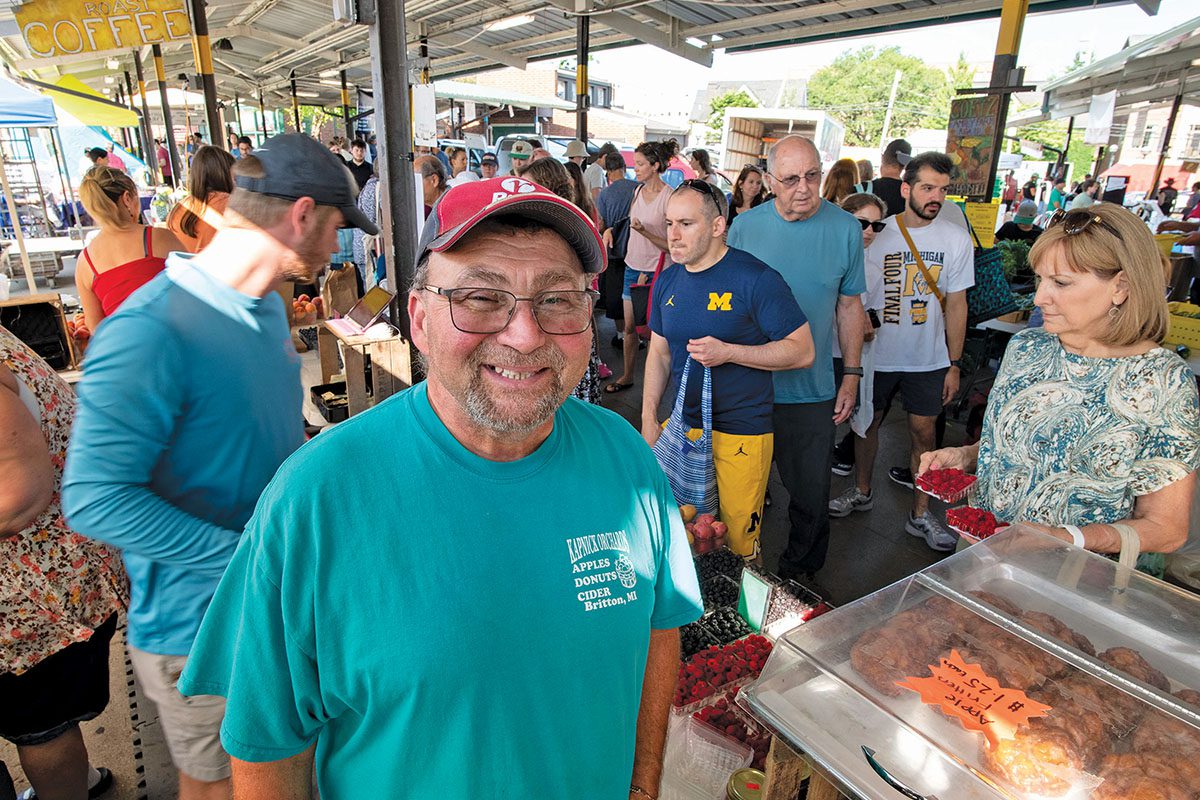
After absorbing smaller increases, Kapnick Orchards co-owner Scott Robertello finally raised prices on blueberries and sweet cherries by $1 a quart this year. What’s driving costs up? “It’s a little bit of everything,” he says. | Photo by Mark Bialek
Grocery prices have climbed 25 percent since the beginning of the pandemic, and farmers like Robertello aren’t immune.
“It’s a little bit of everything,” says the co-owner of Kapnick Orchards, standing under a plastic cover as the vestiges of Hurricane Beryl pelted hardy vendors and shoppers in July. Both supplies and labor costs are up. “We try to price things in even numbers so that it is easier making change,” Robertello says. So instead of a quarter or fifty cents a year, “we might wait two or three years and raise [a price] a dollar.”
A quart of sweet cherries now costs $10, up $1 from last season, and the same with blueberries. But he did not raise prices on tart cherries, and pints of other fruit have stayed the same at $5 each.
Other merchants tell the Observer they’ve had to raise prices on everything from fruit to flowers to prepared foods.
“Prices on everything across the board increased this year,” said greenhouse owner Cheryl Wagner, who specializes in bedding plants and perennials. “Our soil, our containers, our seed prices, our seedling prices, fuel, and electricity” have all gone up.
At the same time, Wagner says she’s tried to keep the biggest hikes confined to larger plants and perennials, which have a longer life than annuals such as geraniums and petunias.
Ferial Rewoldt, who sells Mediterranean food at HumusFalafel, says she’s seen her wholesale prices skyrocket over the past year. Lebanese olive oil, which she buys in Dearborn, has more than doubled, to $28 a gallon.
Her rice, which comes from Egypt, and her California-grown chickpeas have also gone up. So have the three types of cheese she uses in her spinach pie—and the spinach too. As a result, her containers of hummus have risen from $5 to $6, and she’s instituted a similar hike on her falafel sandwich.
Related: Spinach Pie at the Ann Arbor Farmers Market
Prices for hanging baskets of flowers went up this year at Gracias’ Greenhouse, where co-owner Bessie Newberry said she charged $17, and two for $32, versus $16 and $30 last year. Gracias’ did not raise the price of herb plants, which remained $4 each or three for $10. “I do a lot from seed, and seed allows you to keep your prices down,” Newberry says. But she expects to charge more for the vegetables she sells during the fall.
However, some vendors are trying to hold a line. “We’ve kind of made the decision not to raise prices because everyone is struggling now,” says John Roos of RoosRoast Coffee. His most popular coffees have stayed at $16 a bag, $17 for decaf.
He has operated a small stand at the market since 2008, and charges fellow vendors just $1 for a cup of coffee. But Roos doesn’t have to make money at the market—he treats his stall there as a marketing expense. Many new residents tell him they discovered his coffee at the market, then ventured to his two coffee shops.
Related: … as John Roos Arrives
Roos says the 2024 season has been especially challenging for vendors because of nearby construction, which also closed a parking lot at Fourth and Catherine. The market has touted free parking on Wednesdays, although it can be hard to snag a spot among the vendors’ vans and trucks.
On Saturdays, “The only places left to park” are Community High School and the street, says Wagner. “People don’t want the hassle. Older people can’t walk and carry that far.”
Newberry is feeling the pinch in another way. She used to dial back her market presence once spring flower planting season finished in June. These days, Gracias’ runs its stand continuously through the summer, shifting to succulent houseplants until vegetables have ripened and are ready for sale.
“I never get a break now,” she says, laughing. “I have to keep working.”